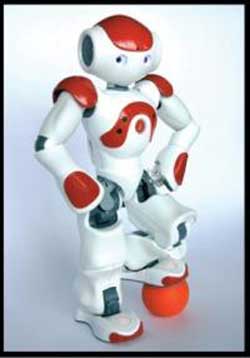How football playing robots have the future of artificial intelligence at their feet

Aldebaran’s Nao robot, used in the RoboCup competition, is available on request. The image should be credited to \"Aldebaran.\"<br><br>Credit: Aldebaran<br>
The author, Claude Sammut, from the ARC Centre of Excellence for Autonomous Systems in Sydney, reviewed the technology demonstrated at the RoboCup international robot soccer competition which this year took place in Singapore. Competitions have become a popular way for motivating innovations in robotics and provide teams of scientists with a way of comparing and testing new methods of programming artificial intelligence (AI).
“Football is a useful task for scientists developing robotic artificial intelligence because it requires the robot to perceive its environment, to use its sensors to build a model of that environment and then use that data to reason and take appropriate actions,” said Sammut. “On a football pitch that environment is rapidly changing and unpredictable requiring a robot to swiftly perceive, reason, act and interact accordingly.”
As with human players football also demands communication and cooperation between robotic players and crucially requires the ability to learn, as teams adjust their tactics to better take on their opponents.
Aside from football the competition also includes leagues for urban search and rescue and robotic home helpers which take place in areas simulating collapsed buildings and residential homes, revealing the multiple use of this technology.
While a football pitch layout is structured and known in advance, a search and rescue environment is highly unstructured and so the competition's rescue arena presents developers with a new set of challenges. On the football pitch the robots are able to localize and orientate themselves by recognising landmarks such as the goal post, yet in a rescue situation such localization is extremely difficult, meaning that the robot has to simultaneously map its environment while reacting and interacting to the surroundings.
In the home help competitions the robot is programmed to recognise appliances and landmarks which will be common in most homes, but in addition to orientating themselves they must react and interact with humans.
As the robotic technology continues to develop the rules of the competitions are altered and made harder to encourage innovation, it is the organisers' aim that this will drive the technology to a level where the football playing robots could challenge a human team.
“In 1968 John McCarthy and Donald Michie made a bet with chess champion David Levy that within 10 years a computer program could beat him,” concluded Sammut. “It took a bit longer but eventually such programs came into being. It is in that same spirit of a great challenge that RoboCup aims, by the year 2050, to develop a team of fully autonomous robots that can win against the human world soccer champion team.”
So while, for the moment, football players can focus on beating each other to lift silverware, tomorrow they may be facing a very different challenge.
This research is published in WIREs Cognitive Science, which, like all WIREs titles, will be made available free of charge for the first two years to institutions that register for online access. To request access for your institution visit: www.wiley.com/wires
Media Contact
All latest news from the category: Interdisciplinary Research
News and developments from the field of interdisciplinary research.
Among other topics, you can find stimulating reports and articles related to microsystems, emotions research, futures research and stratospheric research.
Newest articles

Sea slugs inspire highly stretchable biomedical sensor
USC Viterbi School of Engineering researcher Hangbo Zhao presents findings on highly stretchable and customizable microneedles for application in fields including neuroscience, tissue engineering, and wearable bioelectronics. The revolution in…

Twisting and binding matter waves with photons in a cavity
Precisely measuring the energy states of individual atoms has been a historical challenge for physicists due to atomic recoil. When an atom interacts with a photon, the atom “recoils” in…

Nanotubes, nanoparticles, and antibodies detect tiny amounts of fentanyl
New sensor is six orders of magnitude more sensitive than the next best thing. A research team at Pitt led by Alexander Star, a chemistry professor in the Kenneth P. Dietrich…





















